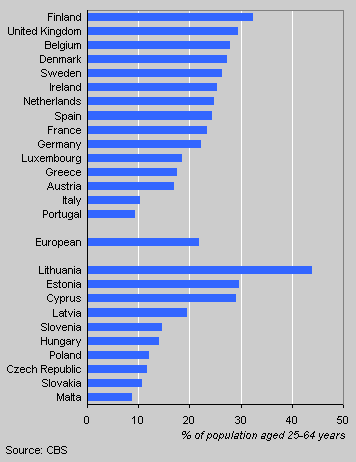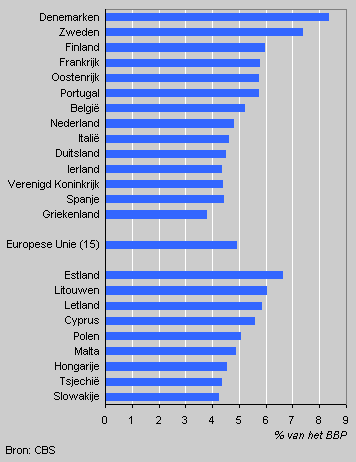Education in Europe

The percentage of people with higher education in the ten new countries of the EU is lower overall than in the fifteen ‘old’ countries. The exception is Lithuania, which scores highest by far: 44 percent of the population aged between 25 and 64 years had a degree in higher education. Total spending on education is at about the same level in the new countries as in the EU-15.
Higher education: Netherlands in step with Europe
The level of education of the Dutch population is reasonably high compared with the rest of Europe. In 2002 nearly 25 percent of the Dutch population aged between 25 and 64 years had completed higher education (i.e. vocational college or university). In the EU-15 this was 22 percent. Italy and Portugal in particular had relatively few people with higher education.
Percentage of population aged 25-64 years with a degree in higher education, 2002

Large differences between new countries
There are large differences in the percentage of people with higher education between the new EU countries. Lithuania beats everyone: no less than 44 percent of the population aged between 25 and 44 had a degree in higher education in 2002. Estonia and Cyprus also had relatively many people with higher degrees.
In the other new member countries the percentage of people with higher education was below the average of the EU-15, however. In Poland, for example, which has the largest population of all the new countries, 12 percent of the population in the age group concerned had completed higher education, less than half the level in the Netherlands. In the Czech Republic, Slovakia and Malta the percentage of higher educated is also low.
Danes spend most on education
Total government spending on education in the Netherlands was about 4.8 percent of the gross domestic product (GDP) in 2000. This is fractionally lower than the average for the EU-15. Denmark
spent most on education ( 8.4 percent of GDP), followed by Sweden (7.4 percent). The Greek government spent 3.8 percent of GDP on education.
Education spending as a percentage of GDP, 2000

Average government spending on education by the accession countries was comparable with that in the EU-15. It was highest in Estonia (6.7 percent of GDP). In Lithuania, too, it was above average. The Slovakian government spent 4.3 percent of GDP on education.
Tanja Traag